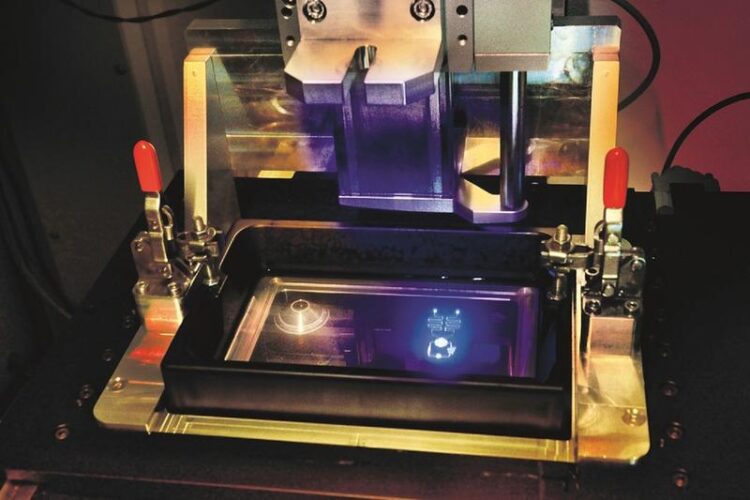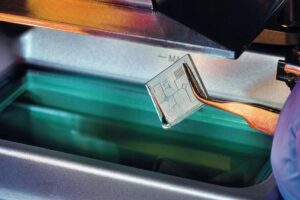Combined and efficient: Two steps to the goal

Realization of MPP and DLP process in one resin bath.
© Fraunhofer ILT, Aachen, Germany
Together with industrial partners, the Fraunhofer Institute for Laser Technology ILT has developed a novel system for producing high-resolution microcomponents by photo-crosslinking. Thanks to their work in the project “High productivity and detail accuracy in additive manufacturing by combining UV polymerization and multiphoton polymerization – HoPro-3D,” polymer microstructures can now be produced economically and customized in one machine.

© Fraunhofer ILT, Aachen, Germany
The experts at the Fraunhofer ILT worked together with LightFab GmbH from Aachen, Bartels Mikrotechnik GmbH from Dortmund and Miltenyi Biotec GmbH from Bergisch Glabach in the “HoPro-3D” project. There they developed a new type of 3D printer that combines fast two-dimensional exposure – scrolling digital light processing (DLP) – with a high-resolution laser process – multiphoton polymerization (MPP) – to produce microcomponents from photopolymers.
The HoPro-3D 3D printer has two selectable exposure systems, for either high build rates (scrolling DLP) or high precision (MPP). The DLP module, which emits at a wavelength of 365 nm, exposes the basic structures of a microcomponent with a pixel resolution of 10 µm. As a complement, a femtosecond laser and the MPP module can be used to write contour lines with a resolution of about 2 µm.
The layer-by-layer approach makes it possible to build the finest MPP structures on top of already printed DLP structures, thus quickly creating extended components with a complex structure and high-resolution details. The built-up laboratory pattern allows the production of components with a footprint of up to 60 x 100 mm².
Combining processes quickly and precisely
The control software of the HoPro-3D system enables users to smoothly switch between the two exposure modules. Moreover, they can use CAD data to decide when it makes sense to switch between the printing processes. During the layer-by-layer build-up of a component, it is possible to switch between the two processes several times.
“The concept is in place and the corresponding machine has been built and already extensively tested,” reports Dr. Martin Wehner, Head of the Biofabrication Group at Fraunhofer ILT. After completion in spring 2022, the laboratory prototype could already be tested and optimized in an application-oriented manner as part of the Fraunhofer SiCellNet network. The SiCellNet cluster forms a central point of contact for research into new tools and manufacturing techniques for the analysis, sorting and provision of living cells. The performance of the combination plant and the control of the process could thus be optimally expanded.
In the follow-up project “Precise assembly by high resolution seamless 3D printing – PANDA,” funded by the SME Innovation Program, the Fraunhofer ILT team has been expanding the performance of DLP-based processes since January 2022. The knowledge gained there will later be applied in the HoPro-3D system to continuously improve the economic efficiency of the 3D printing process.
Applications in biomedical analytics
The Fraunhofer ILT is able to build microchannel structures to develop customer-specific applications in a time- and cost-saving manner. Since there is no need to switch between different machines, smaller functional elements can be integrated directly into larger components. In addition, thanks to increased precision of the MPP process, a high local functional density of microscopic structures can be integrated into components during production.
The potential applications are numerous: Microfluidic chips for laboratory diagnostics and rapid tests, micromechanical components and complete microfluidic systems for efficient point-of-care diagnostics provide on-site diagnostics close to the patient without need further laboratory testing.
The HoPro-3D project ran from November 2018 to December 2021, was coordinated by Fraunhofer ILT and funded by the European Regional Development Fund (ERDF).
Wissenschaftliche Ansprechpartner:
Dr. Martin Wehner
Head of the Biofabrication Group
Phone +49 241 8906-202
martin.wehner@ilt.fraunhofer.de
Maximilian Flesch M.Sc.
Group Biofabrication
Phone +49 241 8906-8372
maximilian.flesch@ilt.fraunhofer.de
Fraunhofer Institute for Laser Technology ILT
Steinbachstraße 15
52074 Aachen
www.ilt.fraunhofer.de
Weitere Informationen:
Media Contact
All latest news from the category: Machine Engineering
Machine engineering is one of Germany’s key industries. The importance of this segment has led to the creation of new university degree programs in fields such as production and logistics, process engineering, vehicle/automotive engineering, production engineering and aerospace engineering among others.
innovations-report offers informative reports and articles covering technologies such as automation, motion, power train, energy, conveyor, plastics, lightweight construction, logistics/warehousing, measurement systems, machine tools and control engineering.
Newest articles

Innovative 3D printed scaffolds offer new hope for bone healing
Researchers at the Institute for Bioengineering of Catalonia have developed novel 3D printed PLA-CaP scaffolds that promote blood vessel formation, ensuring better healing and regeneration of bone tissue. Bone is…

The surprising role of gut infection in Alzheimer’s disease
ASU- and Banner Alzheimer’s Institute-led study implicates link between a common virus and the disease, which travels from the gut to the brain and may be a target for antiviral…

Molecular gardening: New enzymes discovered for protein modification pruning
How deubiquitinases USP53 and USP54 cleave long polyubiquitin chains and how the former is linked to liver disease in children. Deubiquitinases (DUBs) are enzymes used by cells to trim protein…



